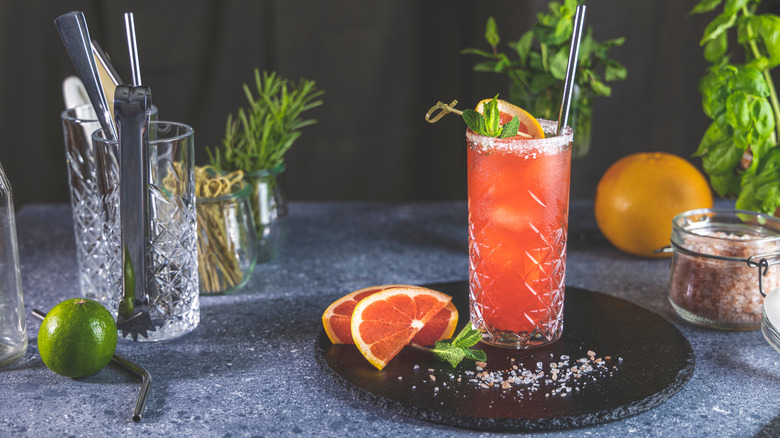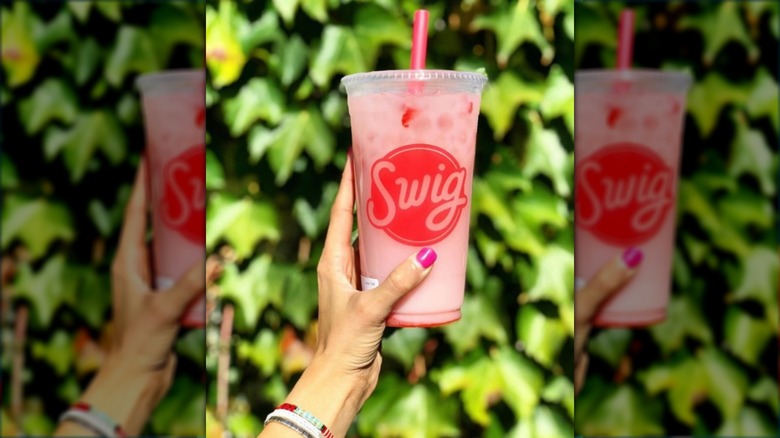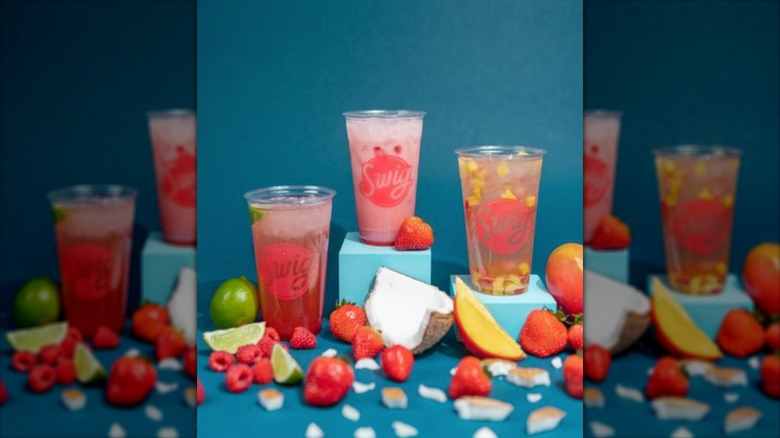Everything You Need To Know About Dirty Soda
Don't call it a comeback. Soda is back and better than ever –- but the "better" part might be subjective.
"Dirty Soda" is a term used for a soft drink such as Diet Coke or Sprite that has been spiked with flavored syrups, fruit purees, and/or dairy products, such as real cream or coconut cream, via Specialty Food. Sound like a sugar headache? Maybe. But the drink is gaining traction like an avalanche coming down a mountain, so it's fitting that it's most avid drinkers live in the Mountain States. Utah is the land of the Dirty Soda, per Vice, and Swig, which deems itself as the "Home of the Dirty Soda," is one of the primary franchises on the market, with 38 locations throughout Utah and Oklahoma, 31 of which are in Utah. Purveyor Sodalicious has emerged as a beverage competitor –- so competitive, in fact, that the two were locked in a court battle for the rights to their star menu item. Talk about fighting "Dirty."
So, what's all the hype about? And, since Dirty Soda first hit the market in the early 2010s, why the recent revival?
Why Dirty Sodas are having a moment
The drink is seeing such a sudden uptick in publicity from an Instagram post. On December 19, 2021, musician Olivia Rodrigo posted a photo of her holding a 32-ounce Swig Dirty Soda. One of Rodrigo's number one hit is a breakup anthem called "Driver's License," which musicology expert Phoebe Hughes says puts the artist in a relative age bracket. The song references getting a driver's license, she explains, which specifically reaches high school-aged listeners.
Perhaps unsurprisingly, the subsequent overlap between Rodrigo fans and TikTok users is massive. The largest age demographic of TikTok users (25% of all accounts, to be exact) is folks between 10-19 years old –- well below the legal drinking age in the U.S. So, when Rodrigo posted the Dirty Soda pic, her sober audience caught a new cue for an unexpected vice. TikTok now has over 700,000 mentions of the #dirtysoda hashtag, reports Eater, the majority of which are marked below videos of users creating their own Dirty Soda recipes at home.
Is Dirty Soda too niche?
It's uncertain whether physical Dirty Soda locations will be able to successfully expand.
Mormons make up nearly 62% of Utah's 3.1 million residents, per Boston Globe, and the Mormon Word of Wisdom prohibits tobacco, alcohol, coffee, and tea, via the Church of Latter-Day Saints. However, sugar and caffeine are still allowed. Kevin Auernig, president of Sodalicious, says that this window of opportunity is exactly what his brand is trying to cater to. "I'm selling experience," Auernig says, via Forbes. "It's like 'Cheers' where everyone knows your name, but we know the orders of regulars." And, clearly, it's been working; Business Insider has even referred to these speciality soda shops as the "Mormon Starbucks."
TikTok might recruit fans of the beverage itself, but physical Dirty Soda shops cater to the social component of sipping a favorite drink –- and the sacred, forbidden enjoyment that accompanies fulfilling a daily vice. So, the longevity of these franchises remains unclear. Soda consumption has been steadily declining since 2005 with per capita consumption decreasing by 25% from 2000 to 2018, reports Statista. Interestingly enough, according to Healthy Food America, the largest demographic decline was sippers between the ages of 2 and 5 and between the ages of 12 and 19. But this resurgence of Dirty Soda and its TikTok fanbase might have something to say about those numbers.


